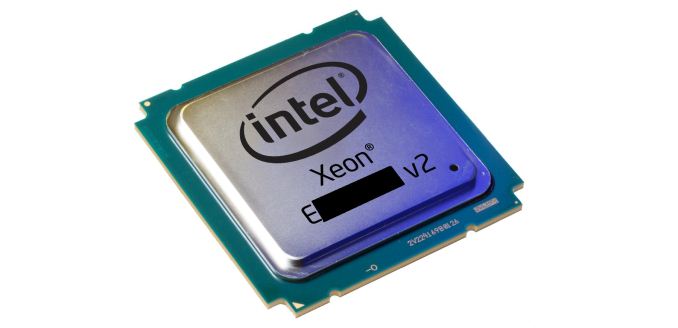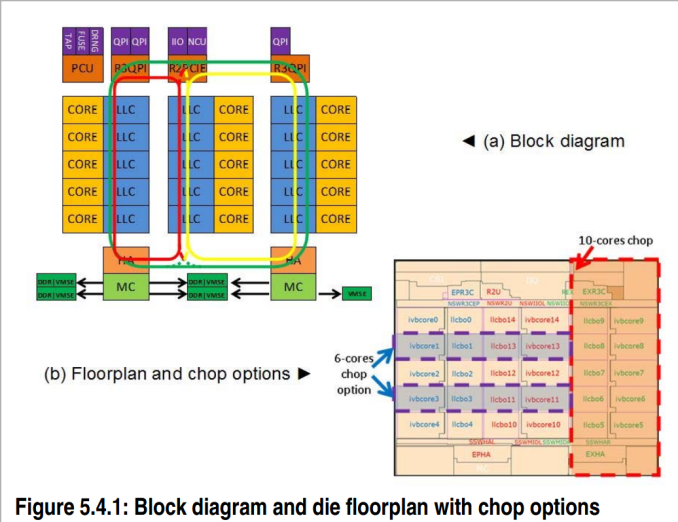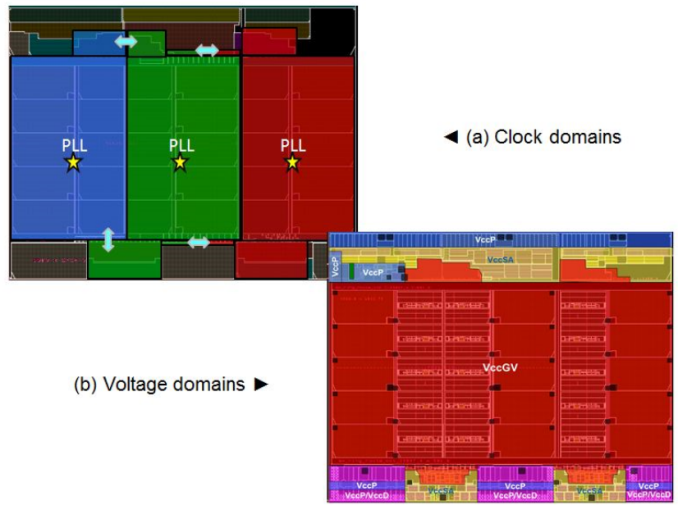Intel Readying 15-core Xeon E7 v2
by Ian Cutress on February 11, 2014 1:32 PM EST
Reports from ISSCC are coming out that Intel is preparing to launch a 15-core Xeon CPU. The 15-core model was postulated before Ivy Bridge-E launch, along with 12-core and 10-core models – the latter two are currently on the market but Intel was rather silent on the 15-core SKU, presumably because it harder to manufacturer one with the right voltage characteristics. Releasing a 15-core SKU is a little odd, and one would assume is most likely a 16-core model with one of the cores disabled – based on Intel’s history I doubt this core will be able to be re-enabled should the silicon still work. I just received the official documents and the 15 core SKU is natively 15-core.
Information from the original source on the top end CPU is as follows:
- 4.31 billion transistors
- Will be in the Xeon E7 line-up, suited for 4P/8P systems (8 * 15 * 2 = 240 threads potential)
- 2.8 GHz Turbo Frequency (though the design will scale to 3.8 GHz)
- 150W TDP
- 40 PCIe lanes
Judging by the available information, it would seem that Intel are preparing a stack of ‘Ivytown’ processors along this design, and thus a range of Xeon E7 processors, from 1.4 GHz to 3.8 GHz, drawing between 40W and 150W, similar to the Xeon E5 v2 range.
Predictions have Ivytown to be announced next week, with these details being part of the ISSCC conference talks. In comparison to some of the other Xeon CPUs available, as well as the last generation:
| Intel Xeon Comparison | |||||
| Xeon E3-1280 v3 | Xeon E5-2687W | Xeon E5-2697 v2 | Xeon E7-8870 | Xeon E7-8890 v2 | |
| Socket | LGA1150 | LGA2011 | LGA2011 | LGA1567 | LGA2011 |
| Architecture | Haswell | Sandy Bridge-EP | Ivy Bridge-EP | Westmere-EX | Ivy Bridge-EX |
| Codename | Denlow | Romley | Romley | Boxboro | Brickland |
| Cores / Threads | 4 / 8 | 8 / 16 | 12 / 24 | 10 / 20 | 15 / 30 |
| CPU Speed | 3.6 GHz | 3.1 GHz | 2.7 GHz | 2.4 GHz | 2.8 GHz |
| CPU Turbo | 4.0 GHz | 3.8 GHz | 3.5 GHz | 2.8 GHz | 2.8 GHz |
| L3 Cache | 8 MB | 20 MB | 30 MB | 30 MB | 37.5 MB |
| TDP | 82 W | 150 W | 130 W | 130 W | 155 W |
| Memory | DDR3-1600 | DDR3-1600 | DDR3-1866 | DDR3-1600 | DDR3-1600 |
| DIMMs per Channel | 2 | 2 | 2 | 2 | 3 ? |
| Price at Intro | $612 | $1885 | $2614 | $4616 | >$5000 ? |
According to CPU-World, there are 8 members of the Xeon E7-8xxx v2 range planned, from 6 to 15 cores and 105W to 155W, along with some E7-4xxx v2 also featuring 15 core models, with 2.8 GHz being the top 15-core model speed at 155W.
All this is tentative until Intel makes a formal announcement, but there is clearly room at the high end. The tradeoff is always between core density and frequency, with the higher frequency models having lower core counts in order to offset power usage. If we get more information from ISSCC we will let you know.
Original Source: PCWorld
Update: Now I have time to study the document supplied by Intel for ISSCC, we can confirm the 15-core model with 37.5 MB L3 cache, using 22nm Hi-K metal-gate tri-gate 22nm CMOS with 9 metal layers. All the Ivytown processors will be harvested from a single die:
Ivytown Die Shot
The design itself is capable of 40W to 150W, with 1.4 GHz to 3.8 GHz speeds capable. The L3 cache has 15x 2.5MB slices, and data arrays use 0.108µm2 cells with in-line double-error-correction and triple-error-detection (DECTED) with variable latency. The CPU uses three clock domains as well as five voltage domains:
Level shifters are placed between the voltage domains, and the design uses lower-leakage transistors in non-timing-critical paths, acheving 63% use in the cors and 90% in non-core area. Overall, leakage is ~22% of the total power.
The CPUs are indeed LGA2011 (the shift from Westmere-EX, skipping over Sandy Bridge, should make it seem more plausible), and come in a 52.5x51.0mm package with four DDR3 channels. That would make the package 2677 mm2, similar to known Ivy Bridge-E Xeon CPUs.
CPU-World's list of Xeon E7 v2 processors come from, inter alia, this non-Intel document, listing the 105W+ models.













55 Comments
View All Comments
Ian Cutress - Wednesday, February 12, 2014 - link
Clicking through to the CPU-World page lists that CPU as not having a Turbo mode. Specifications are still unconfirmed at this point - as mentioned in the piece Intel often does a balancing act of cores/MHz and will never release a max-core model with max-frequency.My original source for the information was a PCWorld article, until I was forwarded the Intel information direct. I have used information from CPU-World as well, who have used a different source.
Ian
GlennAlanBerry - Wednesday, February 12, 2014 - link
I really expect that the E7-2800/4800/8800 v2 family (Ivy Bridge-EX) will have Turbo Boost. We just don't know what the specs will be from the various leaked sources. It is also supposed to have triple the memory density of Westmere-EX, plus PCI-E 3.0 support.omion - Tuesday, February 11, 2014 - link
Minor error correction (which is funny, given the line...)double-error-correction and triple-error-correction
should probably be:
double-error-correction and triple-error-detection
colonelclaw - Wednesday, February 12, 2014 - link
Very frustrating that my company (architectural visualisation) could absolutely make use of these chips in our render-farm, yet our margins mean we will never be able to afford them. Intel's pricing for anything with more than 6 cores is just depressing.I guess we're just unfortunate to be in a no-mans-land market segment that gets use from multi-core CPUs but doesn't generate enough revenue to feast at the high table.
FunBunny2 - Wednesday, February 12, 2014 - link
Well, I suspect Cray has some experience selling such a machine to NSA.Ktracho - Wednesday, February 12, 2014 - link
I suspect NSA is more interested in CPUs that can handle many more threads (on the order of thousands) than Intel CPUs or even SPARC CPUs can. Cray used to make such a CPU, and may still.FunBunny2 - Wednesday, February 12, 2014 - link
Near as I can find, it's been years (or a decade+) since Cray built a machine with a Cray cpu; it's been AMD and Intel. Lots o chips in the cabinet. The interconnects have been Cray's special sauce.fteoath64 - Thursday, February 13, 2014 - link
Yeah, possibly Nvidia Tesla gpu chips as well in their mix since crypto cracking needs plenty of fpu power. These 15core monsters with 4.5 billion transistors certainly are rather power efficient at 150w TDP.SarahKerrigan - Friday, February 14, 2014 - link
Cray - through its YarcData subsidiary - sells machines based on the custom ThreadStorm processor, which is a single-core 500MHz 3-issue VLIW design with 128-thread fine-grained multithreading, based on the 1990's Tera MTA machine. I assume that is what Ktracho was referring to.fteoath64 - Thursday, February 13, 2014 - link
The Opterons 16 cores are cheaper and consume way less power, although they are not as powerful per core as the Intel part. But it seems Intel is responding to the Opteron 16 core release as AMD's pricing is much more reasonable for servers.But I am more concerned with scale upwards in terms of core count. One can see Intel NEEDS a huge L3 cache to keep their cores fed while AMD uses larger L2 cache exclusive to each processor and small L3 cache. When AMD uses HSA for server chips it would be interesting to see who they put as non-cpu compute cores/ Maybe a giant quad-pumped fpu unit cluster that does 4ops per cycle and crunches DP fp32 faster than ever before.